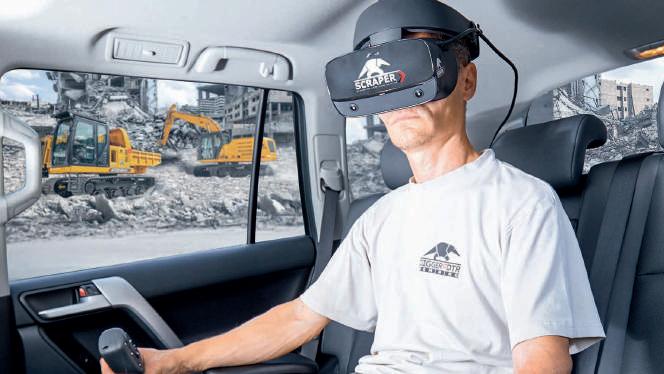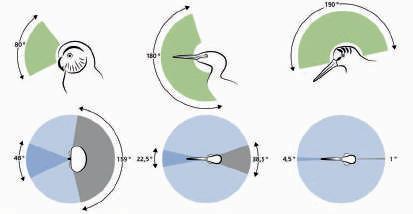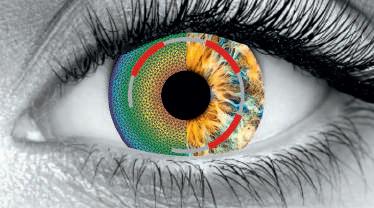
9 minute read
There’s more to vision than meets the eye
Professor Zinkernagel, why is the eye so important to humans?
“The eyes are our primary sense organs; our brain uses about 30 percent of its capacity to process visual information. That is a huge amount and shows how important the sense of sight is for our survival and our daily lives,” explains Professor Martin Zinkernagel, Director of the Department of Ophthalmology at Inselspital Bern. Visual perception not only helps us to find our way in the world around us but also has a significant role to play in social interaction and communication between individuals, the expert reveals: “For example, by reading other people’s body language and facial expressions we can understand their moods and emotions. At the same time, eyes can portray major emotions such as joy, sadness, fear, or affection. Eye contact helps us build trust and empathy.”
Advertisement
How did our eyes develop?
Research suggests that eyes first began to develop about 500 million years ago. From then on they evolved in line with the needs of their owners. “The evolution of the human eye is fascinating. It shows how natural selection helps living things to adapt to their environment and how the complex structure of the eye has benefited our ability to survive and develop,” Professor Zinkernagel explains. “The eyes of early precursors to humans were relatively simple, consisting of only a few light-sensitive cells that allowed them to distinguish light from dark. Over the course of evolution, however, ever more complex forms of eyes evolved that enabled animals to recognize objects in their environment and even track movements.” Evolution can also be seen in the various eye diseases that exist: “In recent decades, myopia has been on the rise. This is partly due to the fact that in the modern world we spend much more time looking at objects up close, particularly screens, books, and other printed matter. This prolonged close-up work, especially at an early age, can cause the eye to elongate and become nearsighted.” Increasing life expectancy also leads to more eye diseases. How does medicine respond to this, and what technologies can help? “I am convinced that systems such as AI will play a key role in making the healthcare system more efficient in the future.”
Professor Sznitman, in what way can AI be used in ophthalmology?
Professor Sznitman, head of the ARTORG Center in Bern, is an expert in AI and computer vision. “In recent years we have been working very closely with the Department of Ophthalmology at Inselspital in Bern to develop a wide range of computer vision systems. These systems help doctors diagnose diseases and assist in predicting how well patients will respond to treatments.” A major part of their joint work consists of combining the clinical understanding of eye diseases with the question of how AI can use this information to create systems that are highly efficient and can consistently evaluate images and data from ophthalmology, he says. A further benefit
The University Hospital Department of Ophthalmology is one of the largest specialist eye hospitals in the country. It provides patient care at the highest level and also occupies a leading international position in eye-related research. In addition to its strong focus on clinical research, the hospital has a very active research laboratory which is embedded in the Department for Biomedical Research at the Inselcampus.
Eye anatomy
How does the eye work?
The eye works in a similar way to a camera: “The process of sight begins with the refraction of light on the cornea and lens, which focus the light onto the retina. The light signals are processed in the retina and then transmitted along the optic nerve to the brain, where the signals are assembled into an image,” Professor Zinkernagel explains. To do this, the eye constantly moves back and forth – several hundred thousand times a day. To ensure that the images do not reach the brain blurred, there are image stabilizers built into the retina. “But the eye can do even more,” says Professor Zinkernagel: “I find it so impressive that the eye can deliver a range of information on our health, including signs of diseases like diabetes and hypertension.” arises in the training of doctors: “AI can play a significant role in compiling and summarizing information. This could be crucial in the years ahead when medical knowledge is generated so rapidly that it could be overwhelming to try to keep up with it all.”
ARTORG is an engineering center embedded in the medical faculty of the University of Bern. Researchers at the center develop technologies that benefit both patients and doctors, for example in ophthalmology.
Can AI see, and what exactly is computer vision?
“I would say that the way computer vision works has much in common with powered flight. Birds were an early inspiration for humans taking to the air, but no aircraft today operates on the same principles as birds. Similarly, early AI and computer-generated images were strongly influenced by human perception,” Sznitman explains. “This no longer happens so much today, and modern AI methods for computer vision are based on mechanisms optimized for computers rather than human physiology.”
Mr. Guerne, how does remote vision work?
Remote vision is used by the SCRAPER remote control system from the Digger Foundation, an NGO based in the Bernese Jura. It enables construction machines of all kinds and makes to be transformed into remote-controlled vehicles. Founder Frédéric Guerne reveals why it is needed. “We develop demining machines. But our main goal has always been to get people out of the machines and into safety.” It all started with remote-controlled Digger machines:
“These are ideal for use in rural terrain. The pilot navigates the machine from a close distance, similarly to a remote-controlled car. The cameras installed on the vehicle produce images that are displayed on the remote control to aid navigation,” Guerne explains.
“The war in Syria showed us that we also need demining machines that can be used in urban areas. But that means the pilot must be able to operate the machine from a safe distance, as if they were sitting in the cabin.” This is made possible by the SCRAPER remote control system developed by Digger. It consists of a stereoscopic camera connected to a VR headset via a high-speed wireless connection that reacts in real time to the wearer’s head movements. The virtual reality environment reproduces the interior of the driver’s cab one-to-one. The system is complemented by professional power and shock absorption controls that enable maneuvering and perfect the sense of immersion. Developing the system was a challenge. “It took two to three years of experimentation by our team of engineers to figure out how to adjust the cameras to make their output feel like natural vision. At first we used only one camera, but that didn’t allow distances to be estimated accurately enough. So we installed two cameras, but that didn’t work out right away either. We then spent some time poring over various studies on vision to find the right settings, the right zoom.” Today, the system works so well that a trained construction machine operator can use the system with no extra instruction. “The operator only works around 20 percent less efficiently than if they were sitting in the driver’s cab itself,” Guerne says proudly.
The NGO Digger Foundation is well-known for its remote-controlled demining machines. The company is based in Tavannes in the Bernese Jura. Its peace-loving tanks will soon be helping to rid Ukraine of mines.
One drawback for Guerne is that the SCRAPER has not yet been deployed in a war zone. There are both cultural and political reasons for this. But Guerne is committed to his mission: “The faces of the deminers who no longer have to risk their lives thanks to our vehicles are what keep me in this business.” Other uses have already been found for this system. “The SCRAPER is being used in France and Switzerland to work with hazardous materials. And we already have interest from the U.S. as well.”
Carmelina
Director,
The School for the Blind in Zollikofen is one of six institutions in Switzerland that provide education for blind and visually impaired people and people with multiple disabilities to prepare them to live independently despite their disability.
Ms. Castellino, can a person see without eyes?
Seeing differently is the credo of the Swiss Museum of the Blind in Zollikofen. But how does that work? “In blind people, the other senses – such as smell, hearing, and touch – are much keener. So they can see with their nose, ears, or fingers,” Carmelina Castellino, director of the Zollikofen School for the Blind, explains. This different way of seeing is also partly in evidence in the language we use, Castellino says, quoting a blind student who describes snow thus: “Today it’s as crunchy as a carrot.” Switzerland officially has about 300,000 blind and visually impaired people. “But the number of unreported cases is much higher,” Castellino adds. “Children with multiple disabilities or adults who lose their sight as they age are particularly likely to slip through the net.” Carmelina Castellino wants to change that by raising awareness of the subject. At what point a person is considered blind or visually impaired depends on their visual acuity. The World Health Organization (WHO) defines blindness as 5 percent or less vision (visual acuity </= 0.05).
At the Swiss Museum of the Blind, which is located on the school’s campus, visitors can experience what blindness or visual impairment feels like. In various activity rooms, they can solve different tasks blind or with glasses that simulate visual impairments. To complement this there is an exhibition room with objects from 200 years of education for the blind, along with video portraits of former and current pupils of the school. The Swiss Museum of the Blind was awarded a Special Commendation by the European Museum Forum in 2022.

Do humans see differently than animals?
“Human vision differs to some extent from the vision of other living beings,” Professor Zinkernagel explains. An important factor is the structure of the retina, which turns light into electrical signals and then transmits them to the brain. Light processing is done by specialized cells known as photoreceptors, and this is generally where the main difference lies: most mammals, including humans, have retinas with two different types of photoreceptors, rods and cones. The rods are particularly sensitive to low light and are therefore important for perception in low light conditions. The cones, on the other hand, are responsible for color perception in good light.
However, some animals have different numbers and types of photoreceptors. For example, birds and some species of fish have four types of cones and can therefore see a wider range of colors than humans.
Another difference is the position of the eyes on the head: humans have two eyes that face forward, allowing the field of vision to overlap. This allows us to more accurately estimate distances and perceive spatial depth. Other animals, such as birds, have eyes arranged on the sides of their heads, giving them a larger field of vision, but they are not as good at estimating distances. Eyes would have evolved in a way that serves the survival and lifestyle of each individual species.
Thus, it can be said that the vision of other animals differs in some respects from that of humans.

Breath Of Fresh Air
CIELOCAM

In Switzerland, several thousand fawns are killed every year by mowing machines during the mowing season. Emanuel Kipfer wanted to put an end to this and equipped a drone with a thermal imaging camera that can detect fawns in long grass, making him a pioneer in drone-based fawn rescue. To be able to offer his services nationwide, he developed the BAMBIKIT: a handmade EASYCHARGE carry case with a fully automatic charging function for the drone, a monitor, and various other useful features. This kit rapidly met with high demand and is now considered the gold standard among hunters and deer rescuers in Switzerland.
As the combination of the professional drone and the EASYCHARGE carry case is also suitable for many other industries, Emanuel Kipfer founded the drone imagery company CIELOCAM. In the near future, CIELOCAM will be launching special complete systems for fire services to support rescue operations and for farmers to assist with herd protection.

ExO
More than 12 million people worldwide suffer from an eye disease called keratoconus, in which the cornea becomes thinner and forms a cone-shaped bulge. This causes distorted and blurred vision. In excess of 250,000 new cases are diagnosed every year.
This type of vision impairment can be alleviated by various methods, including conventional laser treatments that remove tissue to correct vision. The Bernbased startup ExO is working on a new, promising method for individual treatment: an ophthalmic device that makes it possible to inject those affected with a hydrogel to correct their vision.
This medtech device originates from research carried out at the University of Bern and is currently supported by the Venture Fellowship, a collaboration between Inselspital, the Innovation Office and the ARTORG Center.
Ideas, new technologies and inquiring minds constantly inspire new business ideas that give rise to startups. We present four examples in our startup parade.
Startup stage Consolidation
The inventor Emanuel Kipfer
Riggisberg bambikit.ch
Startup stage
Seed (We’re working towards a prototype)
The inventors
Miguel Ariza und Philippe Büchler
Bern









